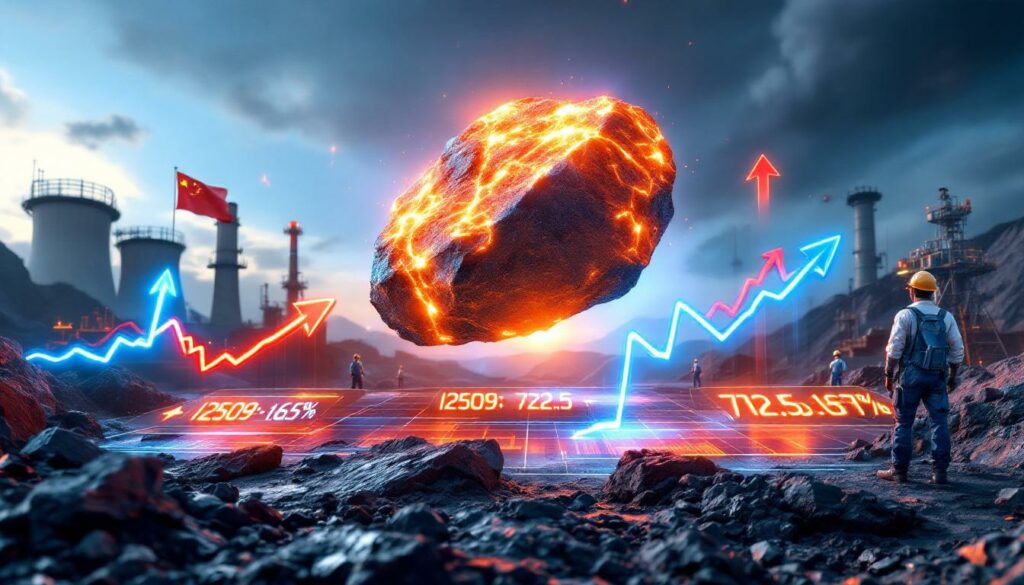Iron Ore Market Today: Intraday Volatility Signals Market Uncertainty
The iron ore futures market displayed significant price swings on July 2, 2025, reflecting ongoing uncertainty among key market participants. The Dalian Commodity Exchange (DCE) saw the most-traded contract I2509 experience a dramatic shift from morning weakness to afternoon strength, ultimately closing at 722.5 yuan/ton with a 1.69% gain for the session.
Trading activity revealed a notable divergence between market participants, with traders actively selling while steel mills adopted a cautious stance. This behavioral split, coupled with decreased inquiry volumes compared to the previous day, suggests potential shifts in the supply-demand balance that could impact future iron ore price trends.
"The intensified wait-and-see sentiment among steel mills indicates growing uncertainty about near-term raw material costs," notes the latest SMM Daily Iron Ore Report (July 2, 2025). "This hesitancy, combined with active selling from traders, created the volatile trading environment witnessed today."
Market Movement Technical Analysis
Today's price action reveals several key technical indicators worth monitoring:
- The 1.69% daily gain reversed the morning weakness, establishing potential support levels
- Decreased inquiry volumes suggest diminishing buying pressure from end users
- Active trader selling into price strength indicates potential supply-side pressure
- Intraday volatility highlights market indecision about near-term direction
The contract I2509 serves as the primary benchmark for market sentiment, with its price movements often dictating physical market negotiations. The afternoon surge after morning weakness demonstrates how quickly sentiment can shift in the current market environment.
Impact on Steel Production and Raw Material Procurement
Steel manufacturers have adopted an increasingly cautious approach to iron ore procurement, with wait-and-see sentiment dominating purchasing decisions. This hesitancy stems from uncertainty about future price forecast insights and concerns about maintaining profit margins in the steel production chain.
The declining inquiry volumes observed on July 2 suggest steel mills may be implementing strategic inventory management, potentially preparing for production adjustments if price volatility continues. Mills typically reduce procurement activities when anticipating price decreases or when facing reduced demand for finished steel products.
Steel Mill Purchasing Strategy Shifts
Steel producers appear to be implementing several strategic approaches:
- Delayed purchasing to avoid buying at potential price peaks
- Inventory optimization to maintain operational flexibility
- Production rate adjustments to align with raw material costs
- Selective grade procurement to maximize cost efficiency
- Futures market hedging to manage price risk exposure
This strategic positioning by steel mills creates a feedback loop affecting iron ore prices, as reduced buying interest places downward pressure on the market despite trader activity.
Factors Driving Iron Ore Price Movements
Multiple interrelated factors continue to influence iron ore price dynamics, creating a complex market environment that requires careful analysis.
Macroeconomic Influences
China's economic policies remain the dominant macroeconomic force affecting iron ore markets. Recent infrastructure investment initiatives aimed at economic stabilization have provided some support for steel consumption, though property sector weakness continues to create headwinds.
The manufacturing sector's performance, as measured by the latest PMI readings, suggests moderate expansion that translates to steady industrial demand for steel products. This balanced outlook has contributed to the market's indecision, with participants weighing positive industrial metrics against property sector concerns.
"Chinese infrastructure investment increased 5.2% year-on-year through May 2025, providing critical support for steel consumption despite ongoing property sector contraction," according to recent National Bureau of Statistics data.
Currency fluctuations, particularly the yuan-dollar exchange rate, have added another layer of complexity for importers calculating landed costs for seaborne iron ore cargoes.
Industry-Specific Factors
Several industry-specific elements continue shaping market dynamics:
- Steel production rates remain approximately 3% below 2024 levels as mills manage utilization rates
- Port inventory levels have stabilized around 125 million tonnes after declining through Q1
- Quality premiums for high-grade ore have expanded as mills prioritize efficiency
- Shipping costs have increased 12% quarter-on-quarter, affecting landed prices
- Production disruptions at Australian mines during the recent cyclone season created lingering supply concerns
The interaction between these factors creates the daily price volatility witnessed in futures markets, with traders and mills continually reassessing their positions based on changing conditions.
Comparison to Recent Market Trends
The current iron ore market displays distinct characteristics when viewed against recent trading patterns.
Weekly Performance Analysis
When examining the past five trading sessions, today's 1.69% gain represents a reversal from the predominantly bearish sentiment that dominated late June. The I2509 contract has established a trading range between 705-730 yuan/ton, with key technical support at the 710 level repeatedly tested but holding.
Trading volumes have progressively increased over the week, suggesting growing market participation and potentially more decisive price action in coming sessions. The volatility pattern shows classic indecision, with larger daily ranges but limited directional momentum.
| Date | I2509 Close | Daily Change | Volume |
|---|---|---|---|
| July 2 | 722.5 | +1.69% | High |
| July 1 | 710.5 | -0.42% | Moderate |
| June 30 | 713.5 | +0.85% | Moderate |
| June 29 | 707.5 | -1.21% | Low |
| June 28 | 716.2 | -0.68% | Low |
Monthly Outlook Assessment
Looking at the broader monthly perspective, iron ore has established a sideways consolidation pattern after the sharp May-June correction. Current prices sit approximately 8% below April's peak but have found apparent support around the 700 yuan/ton psychological level.
The traditional summer slowdown in construction activity has been less pronounced than in previous years, potentially due to accelerated infrastructure project timelines. This seasonal anomaly has contributed to the market's range-bound behavior rather than the typical summer weakness.
Technical indicators suggest the market is approaching a decision point, with the converging price range likely to resolve in a more decisive directional move in the coming weeks.
Strategic Implications for Market Participants
The current market environment presents both challenges and opportunities for various stakeholders in the iron ore ecosystem.
Trader Positioning Strategies
For traders, the volatile conditions require adaptive strategies:
- Risk management becomes paramount during high volatility periods
- Spread trading between different contract months offers reduced directional risk
- Physical-futures arbitrage opportunities emerge during price disconnections
- Position sizing requires adjustment to account for elevated volatility
- Timing entry/exit points around key technical levels provides better risk-reward
The active selling observed among traders today suggests many are taking profits or repositioning ahead of anticipated market shifts. This behavior often precedes significant price moves as professional traders position ahead of the broader market.
Steel Producer Considerations
Steel mills face several critical decisions in the current environment:
- Raw material cost management requires balancing inventory levels against price expectations
- Production scheduling flexibility becomes essential when input costs fluctuate
- Finished steel pricing strategies must accommodate raw material cost uncertainty
- Hedging approaches using futures contracts can lock in margins during volatility
- Alternative input options such as scrap substitution may become economically viable
Mills displaying wait-and-see behavior are effectively implementing a strategic pause to gather more market information before committing to large procurement volumes. This approach often creates self-reinforcing market dynamics that prolong periods of indecision.
Iron Ore Price Forecast
Analyzing current market conditions provides insights into potential price decline analysis over different time horizons.
Short-Term Price Projections
Technical analysis suggests several key levels to monitor in coming sessions:
- Upside resistance at 730-735 yuan/ton (previous weekly high)
- Downside support at 705-710 yuan/ton (recent session lows)
- Breakout target above 740 could see a move toward 760-765
- Breakdown risk below 700 might accelerate selling toward 680-685
The increased trading volume accompanied by today's positive price action suggests short-term momentum may be shifting toward the bullish side, though confirmation requires follow-through in subsequent sessions.
Disclaimer: These price projections are based on technical analysis of current market conditions and historical patterns. Actual market movements may differ significantly based on unforeseen events or fundamental changes.
Medium-Term Market Outlook
Looking beyond the immediate trading horizon, several structural factors will likely influence price direction:
- Supply expansions from major miners are expected to add approximately 40 million tonnes of new capacity by year-end
- Steel demand projections for Q3-Q4 suggest modest growth of 2-3% year-on-year
- Environmental policies affecting Chinese steel production may create periodic demand fluctuations
- Seasonal patterns typically show strengthening in late Q3 as construction activity resumes
- Infrastructure stimulus implementation remains a key variable for demand forecasts
The balance between these factors suggests a moderate bullish bias for the medium term, though with significant two-way risk depending on Chinese policy implementation and global economic conditions.
FAQ: Iron Ore Market Essentials
What are the main factors affecting iron ore prices currently?
Iron ore prices are primarily influenced by Chinese steel production rates, which account for approximately 55% of global iron ore consumption. Key factors include infrastructure investment levels, property sector activity, environmental policies affecting steel production, and supply conditions at major mining operations in Australia and Brazil.
The current market shows particular sensitivity to steel mill purchasing behavior, trader positioning, and inventory levels at major Chinese ports. Monetary policy decisions affecting construction financing also play a significant role in determining demand strength.
How do futures contracts impact physical iron ore trading?
Futures contracts like the DCE I2509 serve multiple market functions:
- Providing price benchmarks for physical negotiations
- Offering risk management tools for producers and consumers
- Creating forward price discovery mechanisms
- Enabling market access for financial participants
- Facilitating market efficiency through arbitrage opportunities
The relationship between futures and physical prices involves a complex interaction where each influences the other. When futures prices move significantly, physical negotiations often pause as participants reassess fair value, creating the wait-and-see behavior observed today.
What indicators should market participants monitor?
Key indicators for predicting iron ore price movements include:
- Port inventory levels and consumption rates
- Steel mill profit margins which influence production decisions
- Blast furnace utilization rates indicating real-time steel production
- Shipping rates affecting landed costs for imported ore
- Chinese property starts and completions data for demand forecasting
- Infrastructure investment statistics showing public construction activity
- Futures market open interest revealing participant positioning
- Steel export volumes indicating domestic oversupply conditions
These metrics provide early signals of potential price direction changes, allowing proactive positioning before broader market movements.
How do seasonal factors affect iron ore markets?
Seasonal patterns create cyclical demand fluctuations throughout the year:
- Q1 (Jan-Mar): Pre-Chinese New Year restocking followed by holiday slowdown
- Q2 (Apr-Jun): Spring construction season peak activity
- Q3 (Jul-Aug): Summer slowdown and maintenance periods
- Q3-Q4 (Sep-Nov): Autumn construction revival before winter
- Q4 (Dec): Year-end inventory management and position squaring
Weather conditions also create seasonal supply patterns, with Australia's cyclone season (December-March) and Brazil's rainy season (November-March) potentially disrupting shipments from these major producers.
Iron Ore Market Data Analysis
Price Performance Metrics
| Indicator | Current Value | Daily Change | Weekly Trend |
|---|---|---|---|
| I2509 Contract | 722.5 yuan/ton | +1.69% | Range-bound with upward bias |
| Trader Activity | Active selling | Increased | Continued aggressive positioning |
| Steel Mill Inquiries | Decreased | Negative | Declining procurement interest |
| Market Sentiment | Mixed | Shifting | Transition from bearish to neutral |
The data reveals a market at an inflection point, with contradictory signals creating the conditions for continued volatility. The positive price action despite decreased buying interest suggests short-covering may have contributed to today's afternoon rally.
Supply-Demand Balance Indicators
| Factor | Current Status | Impact on Price |
|---|---|---|
| Port Inventories | Stable at ~125M tonnes | Neutral |
| Steel Production | Wait-and-see approach | Potentially bearish short-term |
| Trader Positioning | Active selling | Short-term bearish |
| Shipping Rates | Elevated from Q1 | Moderately bullish |
The overall supply-demand balance appears slightly biased toward oversupply in the immediate term, though balanced for the medium-term outlook. The cautious approach from steel mills suggests they are not experiencing urgent restocking needs, which typically indicates adequate inventory levels relative to production requirements.
Further Exploration
Readers interested in deeper iron ore market analysis can explore daily and weekly iron ore reports from specialized providers like SMM, Mysteel, and Platts. These sources offer comprehensive coverage of both physical and futures markets, providing the detailed insights necessary for informed decision-making in this complex commodity space.
For those focused on technical analysis, the Dalian Commodity Exchange provides historical data that allows for more sophisticated pattern recognition and trading model development specific to iron ore futures. Additionally, following developments related to miners' demand spotlight and issues like Ferrexpo VAT issues can provide valuable context for understanding market dynamics.
Disclaimer: This market analysis is based on information available as of July 2, 2025, and represents a snapshot of current conditions. Commodity markets are inherently volatile and subject to rapid changes based on unforeseen events. Readers should conduct their own research and consider their individual risk tolerance before making investment decisions.
Want to Profit from the Next Major Mineral Discovery?
Discovery Alert's proprietary Discovery IQ model instantly identifies significant ASX mineral discoveries, transforming complex data into actionable investment opportunities before the broader market responds. Explore why major mineral discoveries can lead to substantial returns by visiting Discovery Alert's dedicated discoveries page and begin your 30-day free trial today.




